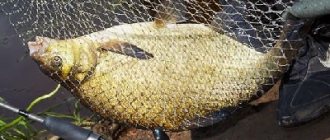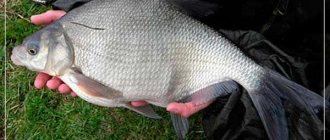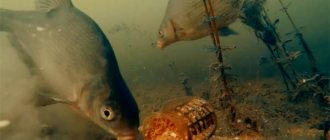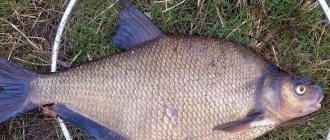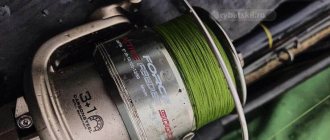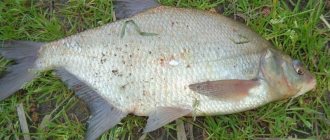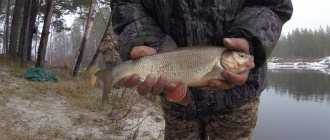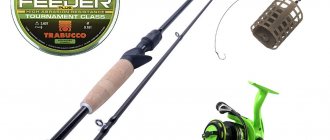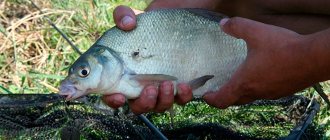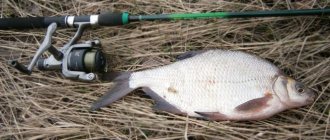Peculiarities of bream behavior in autumn
Bream fishing is most fruitful in the autumn. The fact is that at this time the fish gather in large schools; solitary bream are practically not found. Autumn is the period when it is possible to catch especially large individuals, as they swim to the shallows in search of food due to an abundant lack of protein. However, it is quite difficult to catch the described representatives of the Cyprinidae family at this time.
Autumn fishing requires careful preparation, as well as learning the techniques of fishing with a float rod or feeder. The behavior of fish varies depending on the month, so you should study in detail the information regarding the places where schools appear in a particular period of autumn before planning your fishing.
September
In September, the fish practically does not change its habits. Bream swim alone, not in schools, and search for food. During this period, individuals can be caught in shallow waters where colonies of mollusks are common.
Did you know? Scientists know of 6 species of fish that, in addition to gills, also have lungs in their bodies.
October
The behavior of bream changes dramatically with the arrival of the second month of autumn. In October, they gather in flocks, and together they search for food and a place where they can spend the winter. It is during this period that the fish will actively feed and stock up on “fat” for the winter. This behavior will continue until November, and as you know, the zhora period is a “golden” time for every fishing enthusiast.
November
In November, aquatic inhabitants find depressions at the bottom, where they will spend the rest of the time until warming. Such gullies are called wintering pits. If a fisherman tracks the trajectory of the school, he will be able to enjoy a good bite in winter.
What does it bite on and where to look?
As the temperature drops in autumn, bream gradually begins to move into the pits
At this time of year, the water becomes cooler and clearer, and the fish are more careful and choosy in choosing food.
• Where to look for bream in September
In September, bream practically stops going out into shallow water and occupies holes like catfish in the depths. True, the holes in the riverbeds are not replete with this fish - it will move there much later. You should try to throw the bait at the entrance and exit of these holes. In large bodies of water, if you are fishing with a feeder, picker, or bottom tackle, we can recommend the following type of search.
The tackle is baited with bloodworms, maggots, etc. and is thrown as far as possible. Then wait 5-6 minutes. If there are no bites, then the line is retracted a few meters and we wait again. And so on until the bream bites. The distance at which the bite occurred is marked on the line with a marker, or placed on the reel clip. For comparison, you can see how bream fishing occurs in October.
• Bream activity time in September
With the onset of cold weather, the bream is still active; it gains fat in the winter. But the colder it gets, the less time he devotes to eating. In early and mid-autumn, it feeds actively for about 4 hours per day. Bream is active from sunrise until lunchtime. After lunch and until the evening there is usually no bite. But this fish catches at night until the end of October, although you need to catch it at great depths, in holes.
• What do bream bite on in September?
You need to catch bream in September using the following baits: maggots, bloodworms, dung worms, pearl barley. Very good results are obtained by using so-called “sandwiches”, when several types of baits are attached to the hook at the same time.
Lure
As bait, it is advisable to mostly use small maggots and bloodworms, which must be mixed with the soil. You can also add store-bought plant food for bream, but it also needs to be mixed with soil in a 1/1 ratio and add bloodworms and maggots.
Bloodworms and maggots for feeding are taken “second-class”, i.e. worse than with a nozzle. Millet and pearl barley porridge can be used as plant feeding components.
Method of feeding bream
I would like to dwell a little on the feeding method. Bream is a cautious fish, and in the fall it becomes even more cautious. Therefore, you need to feed him as quietly as possible, i.e. deliver feeding balls by boat, feeding boat, etc. You can throw it by hand, but only make the portions as small as possible.
Remember - in the fall it is the point that feeds, not the area! The bream will not swim headlong for a “treat” from all over the reservoir, as in the summer. The main thing is to create a “commotion” of fish in the place where it is concentrated.
Often, inexperienced fishermen, having found a point where bream are biting, immediately begin to feed, as in the summer (“bombing” with huge “bombs”). As a result, after such feeding, the bites disappear and never return. And if something starts to bite many minutes later, it is usually a small bream, less cautious.
Caution and patience
In autumn, you should be careful about various aromatic additives in fertilizing. It’s better to concentrate on using attractants and flavor enhancers for baits - you can always refuse, and if you add “odors” to the feeding, then the scared off fish will not return to their original place any time soon
In general, I would advise that in the fall, if you find a place where bream feeds, do not use fertilizer. Many fishermen do this, no matter how crazy it may sound, and end up with hefty catches.
• Tackle for catching bream in September
In September, bream prefers (just like in summer) bait that “sways” somewhere near the bottom, on the bottom. Based on this, preference should be given to bottom gear - hooks, feeders, pickers, donks, etc. You can, of course, fish with everyone’s favorite and universal float rod, but in this case you need to use a boat. In the fall, many fishermen prefer donks and feeders. This is explained by the fact that they allow you to fish at a great distance from the shore and search for fish (the method is indicated earlier in the text).
If you use a feeder, then you don’t need to specifically feed the area - all the work of spot feeding will be done by the feeder. The rod for the feeder is selected with a test of 80-120 grams, a reel from 2500 to 4000, a monofilament line from 0.2 to 0.25 mm with fluorocarbon leaders of the same section. The weight of the feeder depends on the test of the rod - 80-120 g. and the strength of the current (the stronger the current, the heavier the feeder is).
Feeder for autumn fishing
The feeder becomes an effective fishing tool in October and November, when the water temperature drops and biting activity decreases.
The fact is that the use of this device gives the fisherman some advantages, namely:
- casting distance increases;
- helps to carry out continuous baiting over a long period of time, since the rod is equipped with a feeding attachment;
- is more sensitive equipment than donka.
Also learn about the characteristics and uses of sea bream.
Rod
The rod is the main part of fishing rods. In autumn, fishing tactics are used when three fishing rods are used simultaneously. They are thrown to various parts of the river in order to search for concentrations of fish. Having resorted to this tactic, they choose the most “fishy” place where feeder fishing will be carried out in the future. The length of the tackle must be from 360 cm and the dough must be at least 90 g.
Line and leash
For fishing during the active biting period, use high-strength monofilament fishing line. It is important to understand that in order for the feeder equipment to be the most sensitive, it is necessary to stock up on low-stretch, thin (0.16 mm) material.
The leash can be made from:
- monofilament or fluorocarbon fishing line;
- soft woven material.
The necessary raw materials for weaving a leash are selected based on what type of equipment will be used for fishing.
Did you know? While studying the life of prehistoric man, scientists discovered fishing gear. They were created about 42 thousand years ago.
Rigging and hooks
The type of equipment is selected based on information regarding the size of the fish, bottom topography and the presence or absence of a strong current. For classic equipment, you can use any hook, but it is preferable to choose Nos. 12–15.
There are several types of feeder equipment. These include:
- Blind equipment . In this case, the fish feeder is rigidly connected to the hook and is motionless, while the leash is attached freely. When choosing this type of equipment, you can fix even the heaviest containers with food, which will allow you to catch large fish. However, there are also disadvantages. The sensitivity of this type of equipment is extremely low, and the feeder will not react to the approach of small fish.
- Sliding is the most sensitive, since the feeder moves freely along the fishing line. This option will be most effective in November, when the fish are least active.
- Self-cutting equipment , which operates due to the mass of the feeder. In this case, the fisherman only needs to bring the fish into the landing net.
- Non-self-hooking requires human attention, since the fish must first be hooked, and then held on the hook and brought into the trap.
- Gardner equipment has high sensitivity. It is effective even if there is a muddy structure on the bottom of the reservoir. The leader retract prevents the line from becoming tangled when casting into the river. Anglers most often resort to Gardner rigs, as they are most effective in the fall.
“You can’t spoil porridge with oil”
Bream loves sweets, but is it worth adding sweet syrups to the bait? The fact is that it is better to add sweetness on the spot so that the prepared mixture does not turn sour along the way and does not scare away large fish. For viscosity, you can add semolina or rolled oats to the porridge. Leshchatniks are convinced that the best porridge consists of millet, not fully cooked peas and fried ground seeds. This bait has an unconditional effect on fish.
Here are some more homemade baits. For current:
- 50 g finely chopped lard (unsalted)
- 100 g breadcrumbs
- 100 g breading or rye bran
- Boiled rice – 100 g
- Ground coriander - a pinch
- Maggot
- Clay or semolina.
For any feeder fishing:
- One glass of peas and millet (cook and mince)
- 1.5 cups twisted dried bread
- 2.3 cups semolina
- 2.3 cups makukha
- Half a glass of flour and cake
- Hercules - 0.5 cups (pre-steamed for 2 minutes).
All ingredients of this recipe are added in sequence from the first point to the last. The aromas and taste qualities of the mixture should be taken care of already on the shore. You need to mix 4 tbsp. spoons of sugar, a teaspoon of cinnamon, salt, 1/3 cup of fish food and a pinch of coriander, not forgetting to add maggot. Live bait is required for September - October, so if maggots or dung worms are not added, it is worth adding dry blood to the mixture, this will definitely direct a school of bream to your place, and maybe more than one.
Where is the best place to fish?
Depending on the month chosen for bream fishing, the locations will gradually change. From the beginning of September to mid-October, fish actively migrate in search of food, as the autumn feeding season begins. If there is no current in the reservoir, fishing in the fall is necessary at depth. This representative of cyprinids does not like a flat bottom, but prefers to migrate near slopes, landslides and holes. It is difficult for a fisherman to find such places from the shore, which means it is necessary to catch fish from a boat. Night is the time when individuals go hunting closer to the shore.
Lure
In the autumn, complementary feeding of bream changes dramatically. When using a feeder, it is very important that the nutritional substance does not fall apart, which means you need to take care of it. During the period of the first frost, you can purchase artificial mixtures labeled “For cold water.” The important thing is that depending on the presence or absence of current in the river, different options should be selected. If the water movement is intense, you need denser baits that will not disintegrate, but for a “calm” reservoir it is necessary that they be well eroded.
You can make your own bait from a mixture of porridge and cake. It is recommended to add artificial flavoring. For bream, it is best to choose cocoa and strawberry aromas, and at the same time make sure that their base is alcohol and not oil, since the former dissolves well in water.
Important! If you only have solid bait, and there is no current in the reservoir, do not be upset - you can mix in river sand to improve looseness.
Choosing bait for the autumn feeder
Until the end of Indian summer, we don’t have to worry too much about overfeeding the fish; the exception may be small, shallow ponds, where the fish are initially not accustomed to heavy feeding. Bait for feeder fishing is no different and includes standard plant ingredients aimed at luring fish and keeping them at the fishing point. All kinds of sweet aromas are used as flavorings (banana, strawberry, tutti-frutti, peanuts).
Features of bait for cold water
With the onset of cold weather, our preferences in choosing bait change significantly; the bait becomes inactive (the number of floating particles is minimal). In the summer, when you bought or made bream bait, and your plans changed, and you went for roach, in order to achieve better results, you needed to acquire bait tailored for roach. Now, even with carp bait, roach and bream can be caught with equal success. The main thing is that it is designed for fishing in cold water. Bait for feeder fishing in the fall should not have large ingredients; all its components should be finely ground, so that the fish will eat, but not get enough. Also, the bait should not be nutritious, so it must be diluted with soil or clay, in cases of fishing in the current. The ratio of dry bait to soil is 1:1, that is, for 1 kg of bait 1 kg of soil. In cases of fishing in the current, when we use clay to make the bait more viscous, the ratio will depend on how viscous the bait we need. If you put too much clay, you can cement it, and it will lie dead weight in the feeder, rather than being washed out by the current. It is imperative to add protein components to the bait (bloodworms, maggots or chopped worms), they are the ones that will force the fish to stay at your point. Moreover, if you are fishing with maggots, then it is advisable that it be included in the bait. For 1 kg of dry mixture, you need about 100-150 grams of animal feed (depending on your budget and the number of other fishermen near you). With the gradual clearing of the water, the color of the bait will become more relevant; it should blend with the bottom, otherwise the fish against its background will be noticeable to predators and will not take risks and approach it. In most cases, our task is to darken the bait; for these purposes, you can use soil, activated carbon tablets or food coloring. It is worth remembering that the colder the weather gets, the less feeder fishing in the fall will depend on bait, since the fish will roll closer to the wintering pits and will not move away from them at the smell of your bait
That’s why it’s so important to find places where it accumulates in late spring.
Flavors for feeders in autumn
Summer aromas do not work in the fall, preferably the spicy smells of cinnamon, pepper, cloves, and you don’t have to buy them specifically in a fishing store. Often fish can become active to shrimp and crab odors.
In order to kill two birds with one stone, you can add fish or meat and bone meal to the bait. This will be both a flavoring agent and a protein supplement that will keep the fish at the fishing point. The ratio of these components in the bait is 10-15% of the volume of the entire bait. You can buy them at any pet store. You can also purchase various dried food for aquarium fish at the pet store and use it as a flavoring agent.
Homemade flavoring
Having mixed the bait, we make a starting feeding of 10-12 throws with feeding troughs. In autumn, the fish may not immediately respond to bait and come up after 1-2 hours. Therefore, it is better to feed first, and only then arrange your place for fishing. We do recasts no more than once every 10 minutes, this is not summer.
Fishing with a feeder in the fall, homemade bait recipes
Recipe 1
- Breadcrumbs 500 grams;
- topcoat 500 grams;
- milk powder 100 grams;
- bloodworm 150 grams;
Recipe 2
- Sunflower cake - 300 grams;
- Boiled millet - 300 grams;
- Rye bran - 300 grams;
- Ground coriander 2-3 teaspoons;
- Bloodworm – 100-150 grams.
Recipe No. 3
- Breadcrumbs - 200 grams;
- Makukha - 200 grams;
- Rye bran – 200 grams;
- Boiled rice - 200 grams;
- Ground coriander – 2 teaspoons;
- Pieces of unsalted lard (5X5 mm) - 100 grams;
- Bloodworm 100 grams.
Feeder fishing tactics and techniques depending on the month
Experienced fishermen know that it is necessary to feed a fishing spot within 3 days. There are certain rules that must be followed in order to attract fish. First, you need to divide the bait into several portions. Secondly, it should be thrown at intervals of 20 minutes.
Thirdly, it should be very quiet on the shore, which means it is better to refrain from talking. At night, fish are in coastal waters, so catching them becomes easier.
Video: Catching bream on a feeder
If fishing takes place on a river where there is a strong current, it is advisable to cast in its direction. The bream, which has already picked up the hook, will rush towards the shelter, and if it swims there, it can fall off the tip. In addition, there is a risk of the line breaking. If the fish managed to hide, you should not continue to fight with the bream; the best option would be to cut the fishing line to avoid damage to the gear.
If there is a strong current, you should not immediately land the fish. It is necessary to let the trophy get tired so that you can pull it out easily. You need to pull in calmly, but not too slowly, otherwise the bream may fall off. In this case, the rod must be carefully swung to the right and left.
You will be interested to learn about feeder fishing for carp and carp.
By adhering to the rules indicated above in the article, you can get a good catch. It is important to make proper preparations for fishing, bait the fish on time and correctly arrange the gear depending on the type of reservoir.
Tackle for catching bream in September
In autumn, bream gather in schools. In September, bream continues to feed in its favorite pits over the summer. He has a little less food, and needs to gain fat before the cold weather. Therefore, in reservoirs with calm water, bream moves more actively and often goes into shallow water. Only its activity begins at dawn and ends around noon, of course adjusted for the weather.
In rivers, bream prefers to move between the riverbed and the edge. Moves actively. Only bait can keep him in a certain place.
The composition of the bait will have to be changed. During this period, bream may be interested in food rich in animal proteins. Bloodworms and maggots must be added to the bait.
In September it is already possible to use winter dry mixtures as the basis for bait. A mixture of bread crumbs and ground sunflower seeds in a 3:1 combination works well, naturally with the addition of proteins (about 30 grams per kilogram of bait mixture).
In most reservoirs, already in September, bream completely abandons bait of plant origin. The best bait at this time is considered to be a large bloodworm. The usual sandwich of bloodworms and maggots does not work very well. This is also true for pure maggots.
Earthworms, worms and dung worms remain good baits for large bream. You just need to use them carefully, without fanaticism. Large bream are very rare and still do not bite often.
In autumn, bream becomes cautious. You can't expect the usual summer gluttony. He bites uncertainly. After several successful bites, the flock can move away from the feeding area.
You can feed in several places and change them periodically. But this applies mainly to floaters.
Necessary gear
Feeder rod of at least 3.9 meters for long casts
The reel is inertia-free (bayrunner is optional), the only condition is a well-tuned and functioning friction brake (rear or front does not matter)
Hooks with a long shank to match the size of the fish’s mouth (usually No. 7-9. Should fit easily into the mouth opening.
In September, bream still lives its summer life. The food supply for him is still quite rich. Moreover, if in August it was very hot and the water level was decreasing, then with the advent of a slight cold snap and rain, the water level in the river rises. Nature transforms a little, it becomes fresh and there is no that debilitating stuffiness. This is felt not only by humans, but also by fish, including bream. Sometimes in September it feeds more intensively than in summer. If in the summer months bream was often caught only at night and a little in the morning, then in September bonus specimens readily bite throughout the day.
The most promising places at the beginning of autumn will be wide reaches and coastal slopes. Why do bream like to visit these particular places at this time? {q} The answer is very simple. There is plenty of food for him here. If we talk about the coastal dump, then in this zone, as a rule, there is a lot of dreacena, larvae, bloodworms and vegetation. In this place, summer life still continues and bream concentrate in schools immediately behind the dump. It happens that the fishing distance is no more than 15 meters.
In this case, you can even use a picker and a small feeder, or feed by hand, and use an ordinary weight on the equipment. But again, this is all relevant for warm September, when the water temperature is above 16 degrees and the weather is good.
If the weather is not so generous, then the bream will mix further into the reaches. Here the water has not yet cooled down much; the food supply is quite rich. In such places there are a lot of shells, underwater algae, and food lingers here well.
However, you should not think that any stretch collects a large number of bream. It is better to look for reaches located near a narrowing channel. These could be river bends, places where the current slows down. When tapping the bottom, pay attention to areas with shells and grass. The boundaries of grass and shells will be promising in the fall for fishing bream on the feeder. Remember that shells are mollusks. They are natural food for fish.
As the weather gets colder, the habitats of bream change. It moves closer to the channel edges and holes. The water here has not cooled down yet and the food supply is rich in plant and animal food. In shallow areas, the grass slowly dies off and there are fewer and fewer larvae and invertebrates. Places with a depth of 2-3 meters turn out to be unpromising for fishing bream.
Pits 4-6 meters deep come to the fore. When searching for places, the emphasis is on distant edges and holes. The feeder is fed into the lower part of the edge or into the pit itself. You can fish the second and third edges with two feeders. This tactic often brings success. Bream usually stands on one of the edges.
It is very important to know the behavior of bream in cold weather in a particular body of water. Experienced fishermen who have been fishing in the same place for many years have studied the habits of bream well. They only fish in areas where they think there might be bream. If this is your first time on the river, then just talk to the local fishermen. They can tell you valuable information and you won't have to waste time catching bream where there are none at that time. Systematic fishing for bream in autumn in separate areas leads to a clear understanding of where it is and how it feeds at different times.
There is a time in autumn when bream can be caught well at night. When the air temperature approaches zero, the bream begins to greedily grab any food. Maybe he wants to get as full as possible before winter. In November, this phenomenon occurs for 4-5 days. Experienced fishermen are well aware of this and literally wait for this time to go night fishing. If the river is rich in bream, then it should show itself at this time. It is better to fish at night near the holes, in the area of the edges.
Advice! When choosing a place, you should take into account that this fish does not like a sandy bottom; the best bream fishing is in September in areas where the bottom is clayey and slightly silted. If you feed well, the fish will also fit in places where rocks predominate on the bottom.
The most effective fishing for September bream on a feeder is possible in the following sections of the river or reservoir:
- clayey shore, where the depth gradually increases;
- a steep bank, where a few meters is already quite deep;
- a gentle bank with a lot of aquatic vegetation, where the depth increases gradually; in this case, a long cast will be required.
Feeder form
Typically, for river fishing, a rod with a length of 3 to 3.5 meters is chosen. In some cases, longer rods are used, but then for casting you should choose a shore free from vegetation. However, sometimes a long rod also helps when fishing on a heavily overgrown bank if you use a pendulum cast.
So, let’s summarize which blank rod to use when fishing for bream on a feeder in September:
- Length - 3.3 meters;
- The action of the rod is fast;
- Rod test - Heavy Feeder “Heavy” up to 150 grams;
- Replacement tip test - (for fishing conditions: current strength, casting distance - feeder weight) - from 60 to 120 grams.
Reel on feeder
The feeder reel is usually used inertia-free. If fishing is carried out in a fast current and the bottom is strewn with large stones, then you need to use a reel with high-speed reeling (with a gear ratio of at least 6:1). The diameter of the spool is selected depending on the diameter of the fishing line.
Reel for fishing on a bream feeder in September:
- Inertialess;
- Coil size from 3000 to 4000;
- The mass of such a coil will be approximately 400 grams;
- The rear clutch is more convenient;
- Gear ratio 4.5:1 or 5:1. The gear ratio of the feeder reel number 5 indicates that the line layer will make 5 revolutions (skeins per spool) with one revolution of the handle. Such reels have proven themselves on the positive side in terms of quality and suitability for feeder fishing.
Characteristics of fishing line and leash:
- To use thin lines, it is necessary to use a shock leader;
- We choose the braided type for the main line. Section diameter up to 0.16 mm;
- Leash for the feeder - fluorocarbon from 0.12 mm, (sports equipment) 0.16-0.18 mm. (optimal).
Now about the hook. It is attached depending on the attachment used.
- Bloodworm - size No. 16-14.
- Maggot - No. 14-10
- For corn, barley, mastyrka, hominy, you can take medium sizes: No. 14-8.
- For the worm, you can choose a medium or long forend with No. 10-6
The bait for September bream can be different, but, as a rule, they are caught with bait of animal origin
- maggot,
- worm
- bloodworm.
- barley shell.
Although bream is not particularly capricious, you have to experiment for a better bite:
- A combination of baits will help out so well: a worm with maggots; maggot with bloodworms; maggot with corn and a lot of others.
- Using mini boilies. Bream boilies have a variety of flavors and are worth trying and combining with animal baits.
- Try flavors, dips and more. Add to feeder or bait.
Before fishing, it is advisable to feed the area and it is better to do this in advance, at least a day in advance. And if the fishing area is chosen correctly (on the path of bream movement or in the parking area), then the likelihood that you will return from fishing with an impressive trophy increases significantly.
A common bait for bream is porridge, which contains millet, peas and the addition of ground crackers. This is the base, but amateur fishermen often put other ingredients in it, in their opinion, this only increases the feeding properties of the base.
Modern ready-made baits for feeder fishing also attract bream well. But the main component that will detain a large bream at the point is simply necessary to use. It may differ in different places. Somewhere bream respects soft sweet corn or boiled peas. Don’t forget about pearl barley, steamed grain, millet, and so on.
- We choose a place. We prepare a comfortable area for fishing. Bushes and trees growing behind can cause difficulties when casting the feeder. But as they say, the fish don’t stick where the fisherman is comfortable, so make the right choice.
- We are preparing the bait. Store-bought mixtures must sit for at least 10 minutes.
- After preparing and laying out the equipment, we measure the bottom with a marker sinker or echo sounder. We clip on and carry out primary feeding consisting of 5-10 feeders.
- We re-cast every 3-5 minutes.
- feeder rod 3-3.3 m long;
- inertial coil;
- heavy feeder - weighing up to 250-300 g;
- fishing line 0.3-0.5 mm thick (depending on the strength of the current);
- fishing line leash with a diameter of 0.2-0.3 mm and a length of 30 cm;
- sharp and small hooks (No. 7-9).
